|
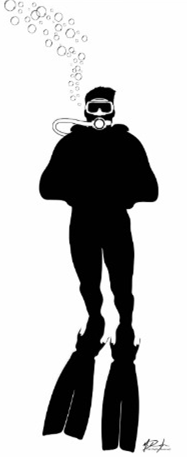

Dive Log
Back to

Back to

|
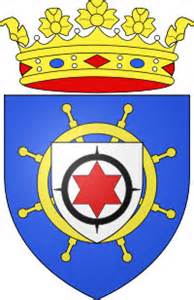
Bonaire, Netherlands Antilles
June, 1981
I would like to think that the fact that
we never had a bad dive trip was the result of hours of
research, but for the most part we just lucked out.
Our selections were based on articles we read in dive magazines.
We would select a geographic area we would like to dive - never
diving the same island twice - and then go through back issues
of magazines to find out what facilities and services were
available. To date, we have not been disappointed and in
many cases our selection, after seeing the competition first
hand, was fortunately for us the best choice. Such was the
case in 1981 when we chose to dive Bonaire - the peak of an
underwater mountain in the Netherlands Antilles - and stay at
the Flamingo Beach Hotel.
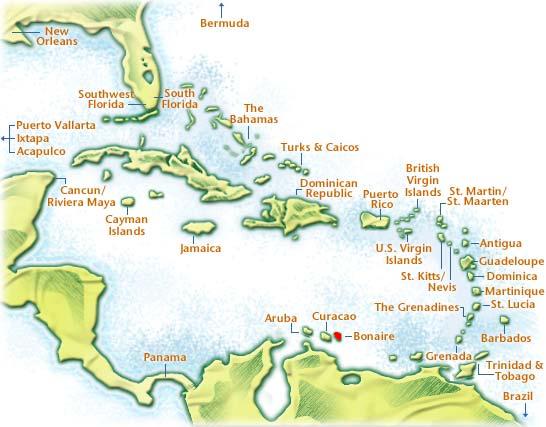
|
A bit of history...
The word "Bonaire" is said to derive from the native "bonah" or
low country. Or it may come from
the Caquetio word 'Bonay'. The early Spanish and Dutch modified
its spelling to Bojnaj and also Bonaire, which means "Good Air".
Bonaire was part of the Netherlands Antilles
until the country's dissolution on 10 October 2010, when the
island became a special municipality within the country of the
Netherlands. It is now considered the Caribbean Netherlands, or
BES Islands comprising three special municipalities located in
the Caribbean: the islands of Bonaire, Sint Eustatius, and Saba.
Bonaire's earliest known inhabitants were the
Caquetio Indians, a branch of the Arawak who came by canoe from
Venezuela in about 1000 AD. Archeological remains of Caquetio
culture have been found at certain sites northeast of Kralendijk
and near Lac Bay. Caquetio rock paintings and petroglyphs have
been preserved in caves at Spelonk, Onima, Ceru Pungi, and Ceru
Crita-Cabai. The Caquetios were apparently a very tall people,
for the Spanish name for the ABC Islands was 'las Islas de los
Gigantes' or 'the islands of the giants.
In 1499, Alonso de Ojeda arrived in Curaçao
and a neighboring island that was almost certainly Bonaire.
Ojeda was accompanied by Amerigo Vespucci and Juan de la Cosa.
De La Cosa's Mappa Mundi of 1500 shows Bonaire and calls it Isla
do Palo Brasil or "Island of Brazilwood." The Spanish conquerors
decided that the three ABC Islands were useless, and in 1515 the
natives were forcibly deported to work as slaves in the copper
mines of Santo Domingo on the island of Hispaniola.
In 1526, Juan de Ampies was appointed Spanish
commander of the ABC Islands. He brought back some of the
original Caquetio Indian inhabitants to Bonaire and Curaçao.
Ampies also imported domesticated animals from Spain, including
cows, donkeys, goats, horses, pigs, and sheep. The Spaniards
thought that Bonaire could be used as a cattle plantation worked
by natives. The cattle were raised for hides rather than meat.
The Spanish inhabitants lived mostly in the inland town of
Rincon which was safe from pirate attack.
The Dutch West India Company was founded in
1621. Starting in 1623, ships of the West India Company called
at Bonaire to obtain meat, water, and wood. The Dutch also
abandoned some Spanish and Portuguese prisoners there, and these
people founded the town of Antriol which is a contraction of "al
interior" or "inside." The Dutch and the Spanish fought from
1568 to 1648 in what is now known as the Eighty Years War. In
1633, the Dutch, having lost the island of St. Maarten to the
Spanish, retaliated by attacking Curaçao, Bonaire, and Aruba.
Bonaire was conquered in March 1636. The Dutch built Fort Oranje
in 1639.
While Curaçao emerged as a center of the
slave trade, Bonaire became a plantation of the Dutch West India
Company. A small number of African slaves were put to work
alongside Indians and convicts, cultivating dyewood and maize
and harvesting solar salt around Blue Pan. Slave quarters, built
entirely of stone and too short for a man to stand upright in,
still stand in the area around Rincon and along the saltpans as
a grim reminder of Bonaire's repressive past.
During the Napoleonic Wars, the Netherlands
lost control of Bonaire twice, once from 1800 to 1803and again
from 1807 to 1816. During these intervals, the British had
control of the neighboring island of Curaçao and of Bonaire. The
ABC islands were returned to the Netherlands under the
Anglo-Dutch Treaty of 1814. During the period of British rule, a
large number of white traders settled on Bonaire, and they built
the settlement of Playa (Kralendijk) in 1810.
From 1816 until 1868, Bonaire remained a
government plantation. In 1825, there were about 300
government-owned slaves on the island. Gradually many of the
slaves were freed, and became freemen with an obligation to
render some services to the government. The remaining slaves
were freed on 30 September 1862 under the Emancipation
Regulation. A total of 607 government slaves and 151 private
slaves were freed at that time.
In 1867 the government sold most of the
public lands, and in 1870 they sold the saltpans. The entire
population became dependent on two large private landowners, and
this caused a great deal of suffering for many people. Many
inhabitants were forced to move to Aruba, Curaçao, or Venezuela.
During the German occupation of the
Netherlands during World War II, Bonaire was a protectorate of
Britain and the United States. The American army built the
Flamingo Airport as an air force base. After Germany invaded the
Netherlands on 10 May 1940, many Dutch and German citizens were
interned in a camp on Bonaire for the duration of war. In 1944,
Princess Juliana of the Netherlands and Eleanor Roosevelt
visited the troops on Bonaire.
On 10 October 2010, the Netherlands Antilles
was dissolved. As a result, the government of the Netherlands
assumed the task of public administration of the Caribbean
Netherlands or BES Islands comprising Bonaire, St Eustatius and
Saba. The three islands acquired new status as "special
municipalities", making them part of the Netherlands itself (bijzondere
gemeenten), a form of "public body" (openbaar lichaam) as
outlined in article 134 of the Dutch Constitution.[12] Special
municipalities do not constitute part of a province.
As a special municipality, Bonaire is very
much like ordinary Dutch municipalities in that it has a mayor,
aldermen and a municipal council, and is governed according to
most Dutch law.
|
The Flamingo Beach Hotel
was a paradise in paradise. The cuisine was excellent with
a selection unparalleled - more about that later. The dive
operation was owned by a man whose name became synonymous with
diving in the Caribbean - Peter Hughes.
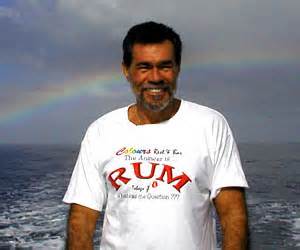 |
When we
first met Peter, he was just beginning to build what
would later become a diving empire. Tragically,
on Monday
evening October 8th, 2001 Hurricane Iris slammed into
the coast of southern Belize causing mass destruction of
the country's infrastructure and banana crop. She also
capsized a luxury yacht carrying 20 members of the
Richmond (Virginia) Dive Club who were in Belize for a
week of rest, relaxation, and scuba diving.
Of the nearly two dozen
boats that sought shelter from the storm at Big Creek
Harbor only one sank; the M/V Wave Dancer, owned and
operated by Peter Hughes Diving. Seventeen divers and
three crew members, parents, grandparents, friends,
sons, daughters, young and old, most trained and
experienced in handling all types of underwater
emergencies, drowned in 12 feet of water when the Wave
Dancer capsized and flooded. |
In 2010,
Peter Hughes announced his resignation as
President of Peter Hughes Diving, Inc. and the Dancer Fleet.
Having built the live-aboard dive boat company from scratch over
the past 25 years, Hughes reluctantly knew he had to sell the
company in 2008 as a result of mounting debts due to the rapidly
collapsing global economy.
Peter's operation in Bonaire was
professional in every sense of the word. On islands where
time for seems to have no meaning or value, Peter's dive
operation ran with precision and accuracy emphasizing guest
service. All a diver had to do was select one of two dives
offered at the time, sign their name on the chalk board, and
show up on time. Your gear would be stowed on the boat,
attached to a fresh tank and ready to go. The Dive Master
would never know which boat Peter would go out on for the day.
it was a system we would see in other Hughes operations.
In fact, if a hotel advertised that it was associated with Peter
Hughes, we would be more likely to choose it over others.
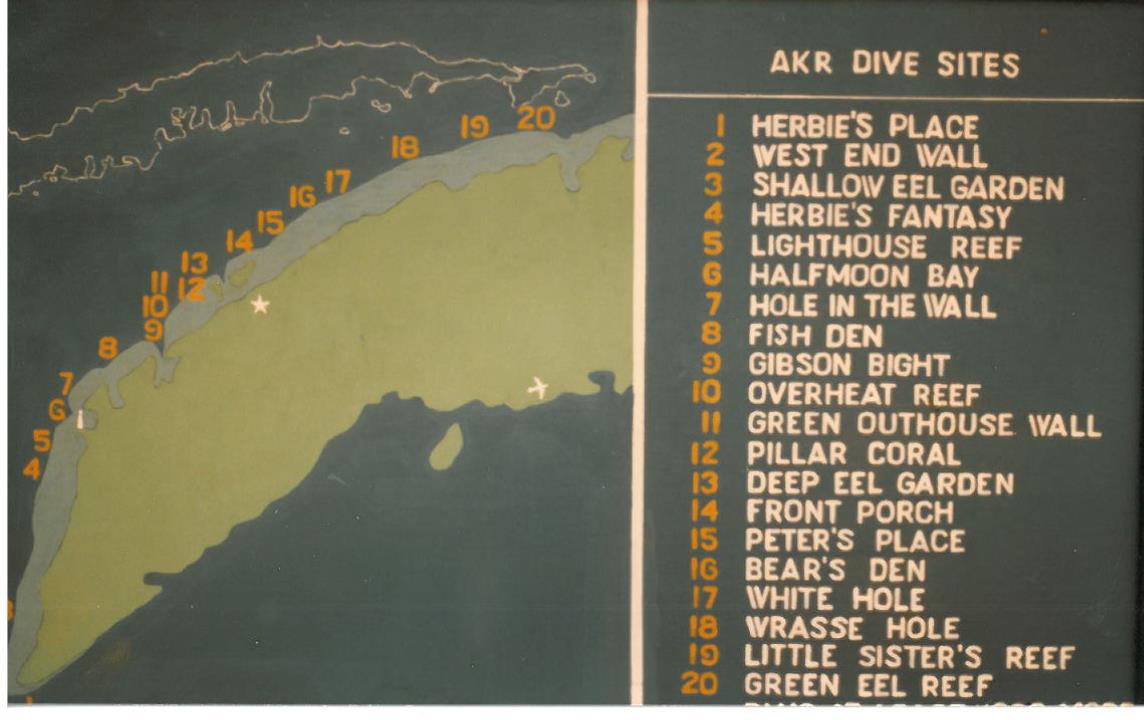
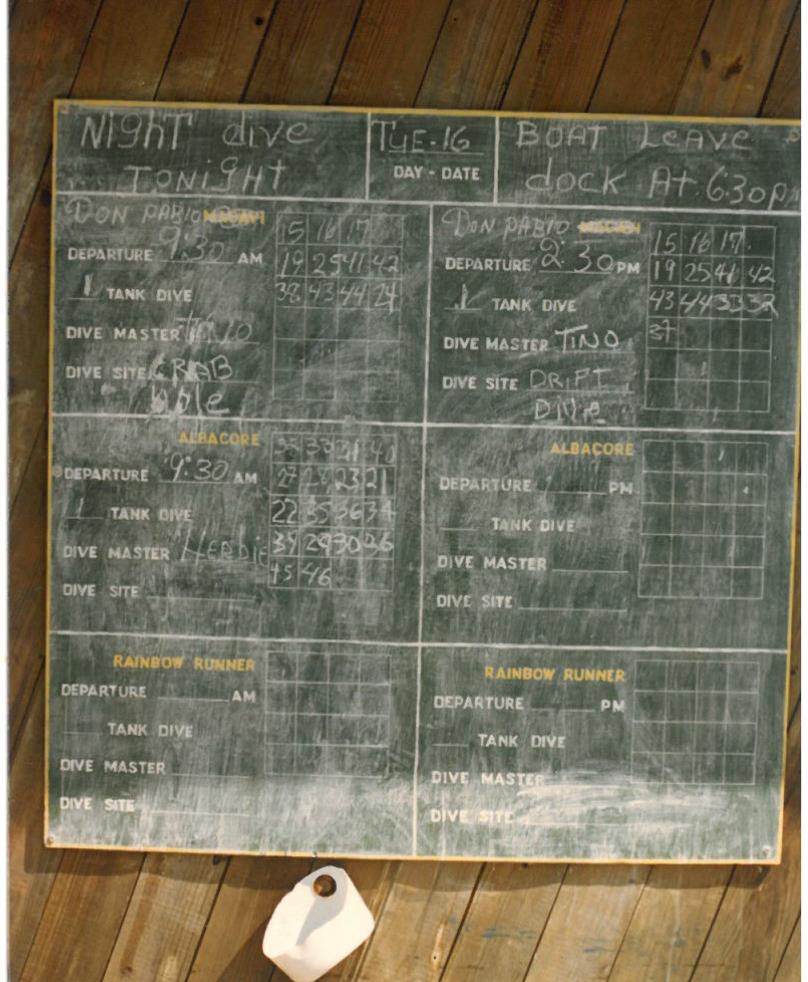
This trip was also the first for some new
dive equipment for us, namely the ScubaPro Mark 4 regulators
which looked remarkably like the helmet of Darth Vader from the
recently released Star Wars movie. Diving equipment seems
to change as rapidly as car designs. With new technology
come new gadgets or gadgets for other gadgets to update your
supposedly sophisticated cutting edge equipment you purchased
just last year. Basically we haven't replaced equipment
unless it had to be replaced - broken straps et. or to make our
equipment lighter for travel.
Back to the trip...After arriving at the
island and the typical trip to the hotel, we had a complimentary
drink and tour of the facilities, and booked our first dive.
The first dive on any trip is known as the
"checkout dive." It's an opportunity for the diver to
check over equipment that hasn't been used in a year, and it's
also an opportunity for the Dive Master to check out the divers
to gauge what kind of Bozos they'll have for the week. The
checkout dive is typically in shallow water or sometimes from a
beach. Ours happened to be off the end of the dock at the
hotel which was fine with us since the island, being a mountain
top, is surrounded by a reef and was excellent diving. The
water was a comfortable 82. It was a nice coral reef with
spotted eels, sea snakes, angel fish, etc.
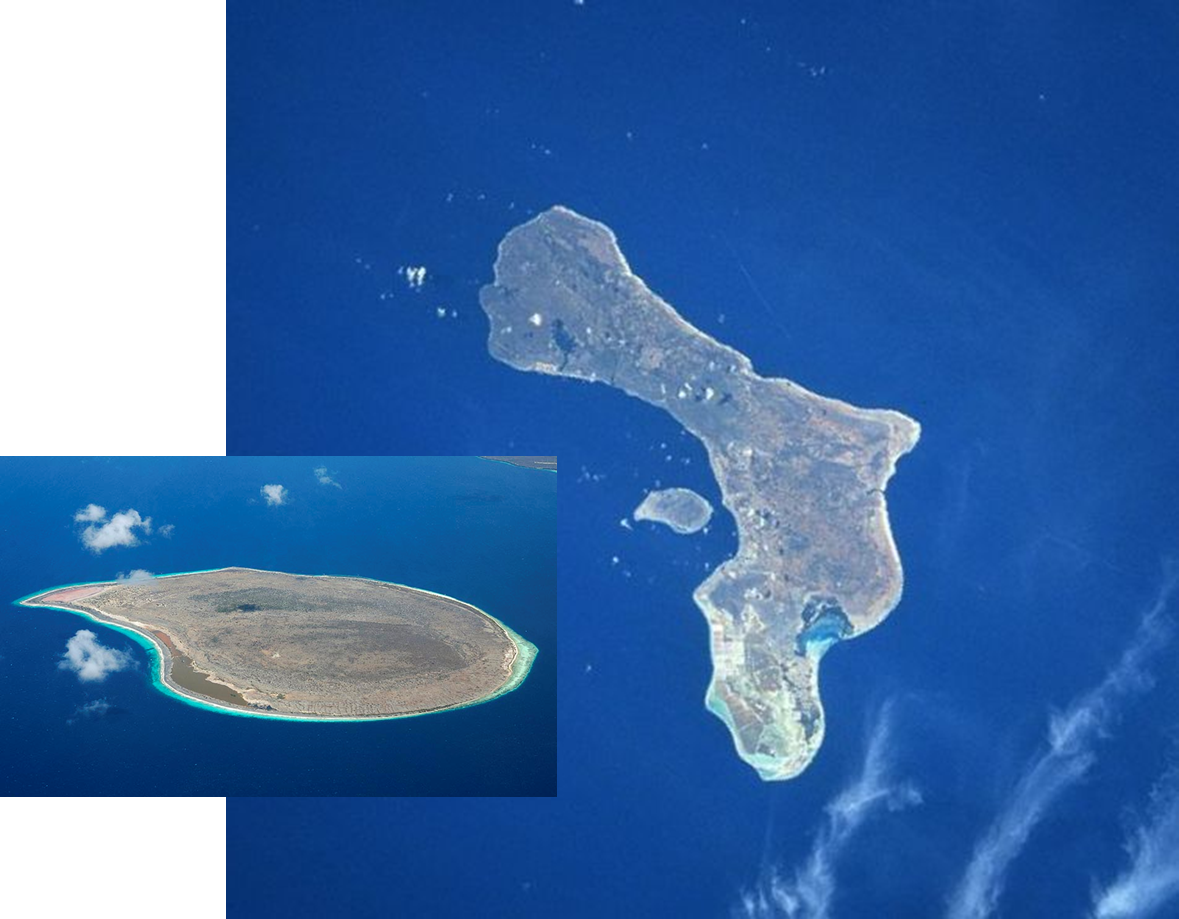 |
Many of
our dives were off a smaller island called Klein Bonaire
or Little Bonaire - a flat uninhabited 1,500 acres
island off the west coast.
"Leonarra's Reef" was just such a
dive. A beautiful coral reef and a leisurely dive
at 40 feet. The majority of our dives were made at
30 to 40 feet simply for the reason that the deeper you
dive, the more colors you lose. Reds and yellows
are lost first. Greens turn to blue, etc.
And, the deeper you dive, the shorter your dive time.
"Twixt" was a lesson in navigation
and an experience we were not soon to forget - certainly
not an experience we wanted to repeat. In most
situations, the Dive Master will lead the dive or at
least make recommendations as to the route you should
take and depth. In our early years of diving, our
philosophy was to cover as much ground as we could to
see as much as possible. A tactic we soon changed.
|
We entered the water, I took an initial
compass reading, and we headed off in the recommended direction
as fast as our little flippers could take us. While with
the group, I somehow managed to swim right by a moray eel that
the others swore came out after me as I passed and measured as
big around as my waist and at least seven feet long. I'm
sure we missed other sights as we quickly swam on. Forty
five minutes into the dive and we were down to 600 psi of air.
It was time to come up, but there was no anchor line.
We looked at one another through our face
masks and I got the well-you've-got-the-compass look from Dad.
I gave a shrug and the signal to surface. We had, or I
had, overshot the boat by what seemed to be a quarter of a mile.
Swimming on the surface with an inflated buoyancy device is not
difficult, but it is tiring. We were exhausted by the time we
belly flopped onto the platform of the dive boat. A lesson
well learned and a painful reminder that we are, after all,
guests in an environment that is not natural for man.
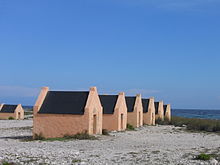
.jpg)
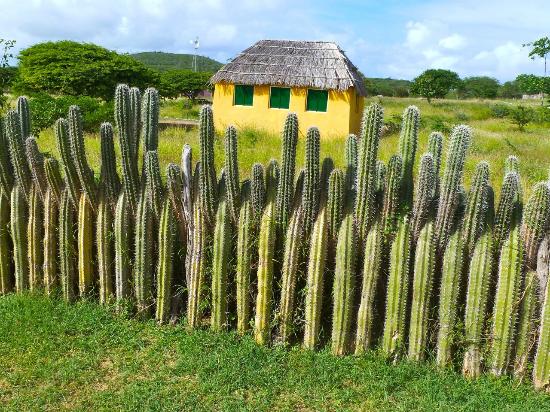 |
"Salt City" was a dive near the salt
pans on the southern shore of the island - an area we
would visit on land during our stay. As noted
above in the history, the Dutch West Indies Company
developed salt pans and agriculture on Bonaire using
slaves brought from Africa. The Arawak Indians of
the island were too small to handle the labor of mining
- as was the case on Grand Cayman.
Large squares, about a quarter of
an acre, are shallowly dug leaving a rim. The salt
water is pumped in and allowed to evaporate. The
remaining salt is then harvested. The living
conditions for the salves was less than human.
Sleeping quarters were designed so that slaves could not
lay straight or stand up. It was an effective
means of control and a testament to the colonial view of
white supremacy. The slave huts remain as a
reminder of the previous conditions, and salt production
continues today under the hum of mechanization.
The salt pans, no longer serving
the Dutch West Indies Company fill with rain water and
now serve as the nesting grounds for the pink flamingo.
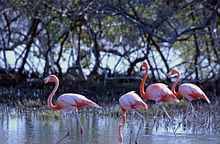 |
God must surely have a sense
of humor to create a bird with knobby knees that
bend backwards, long legs, and bright pink
feathers. The nest of the flamingo is just
as comical as the bird but quite effective.
The flamingo constructs a conical nest from
twigs and mud and lays a single egg on top of
the cone. Mother simply walks up to the
nest, raises her tail feathers a bit, squats,
and covers the egg.
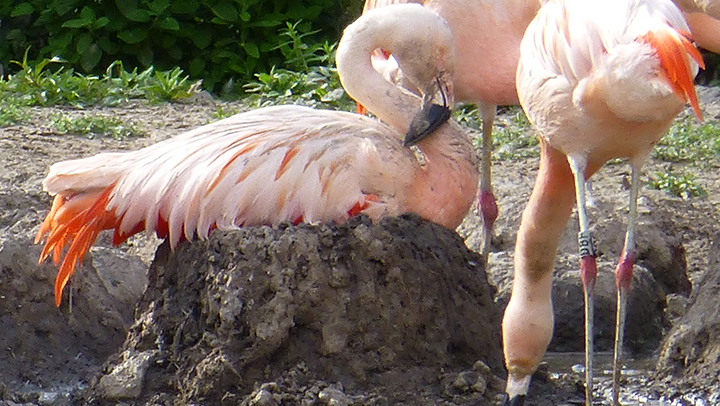 |
|
Another inhabitant of the island and
remnant from the earlier Dutch settlers, are goats. Goats
are everywhere. They were used for meat and cheese as well
as milk. Not so unusual except in how the natives fenced
them in or out of an area; they used cactus. Tall cactus
was planted in rows forming an impenetrable hedge.
Breakfast at the Flamingo Beach Hotel was
extraordinary. The main dining area was open under a
latticed roof with small tables to seat four. You got in
line early, but you weren't in line for very long. After
picking up your plate and selecting from a variety of fruits and
breads, you placed your order for the main course with an
attendant who relayed the ticket to a short-order cook.
The proficiency of this cook was staggering. He would be
working on four to six meals varying from eggs of any style,
bacon, ham, pancakes, or French toast. By the time you
reached the stove, your order was hot and ready. A true
proficiando. After seating ourselves, we were usually
joined for breakfast, lunch, and dinner by a number of
bananaquits - a small yellow and black bird about the size of a
gold finch - that would come to the tables looking for scraps
and handouts, especially sugar. They would land right on
the tables as you were eating.
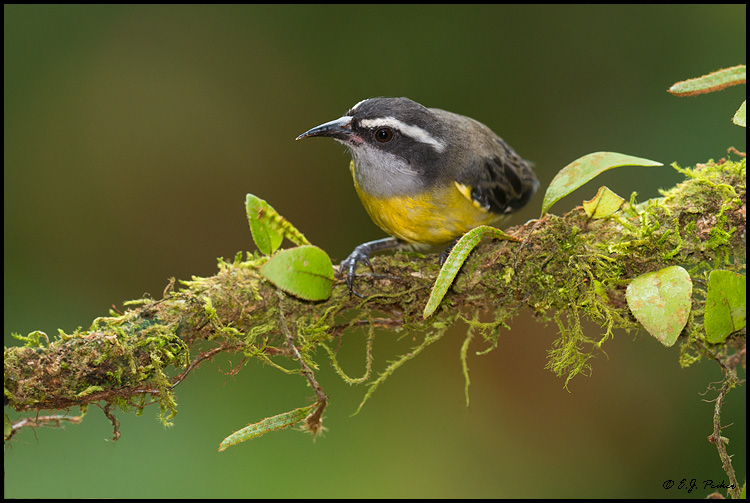
Evening meals were available in the same
are, or for an extra treat (and expense) there was a small
terrace with limited seating and a more exclusive menu.
The renown of their restaurant was known throughout the island.
Wealthier patrons would wine and dine and listen to the soft
strumming of guitars.
"Alice in Wonderland" is probably one of
my favorite dives and is the frequent basis of comparison for
other dives. On this particular dive, a photographer from
the island's Promotion Bureau was snapping away. He wasn't
long in finding subject matter for his pictures. The reef was
abundant with snapper, angel fish, trigger fish, and barracuda.
It really was a trip to fairyland.
We finished the week diving "Sampler",
"Jerry's Jam", and "Angel City."
The diving was excellent as were the
accommodations. Bonaire boasts of 365 days of storm-free
diving. The weather was beautiful. It did, however,
bring out the "strange" in one guest.
Our trip coincided with that of the Texas
Ski and Dive Club. They were a nice group of people who
like to live it up and show it off. Sitting poolside one
warm afternoon relaxing before our next dive, we spied what was
the epitome of ridiculous. One of the Texans was headed
for the boat walking with his flippers on, wearing a thin pair
of long trousers, a large knife strapped to the inside (wrong
side) of his leg, long-sleeved shirt, backpack, extra pony tank,
and his prescription face mask pulled down. The only thing
he was short of, other than his marbles, were his tank and
regulator which were already on the boat. He was a sight
to behold.
Nightlife and entertainment are usually
scarce at the hotels, but we never ventured into town. We
were entertained one evening by a group of young musicians
performing ritual dances in island costume to the beat of
Calypso music. To date, it is the only time we have heard
steel drums in the islands. People think Calypso when they
think of Caribbean music. In fact, the most popular music
when we were diving was country western and swing; native music
was a rarity.
On June 22 we flew out of the islands and
stowed our gear for yet another year when we would return to
some enchanted island to experience the culture and charm of a
lifestyle so different from our own. I hope that Bonaire
does not become ensnared by the lure of tourism to the point of
compromising the character of the island.
Back to

Back to

|